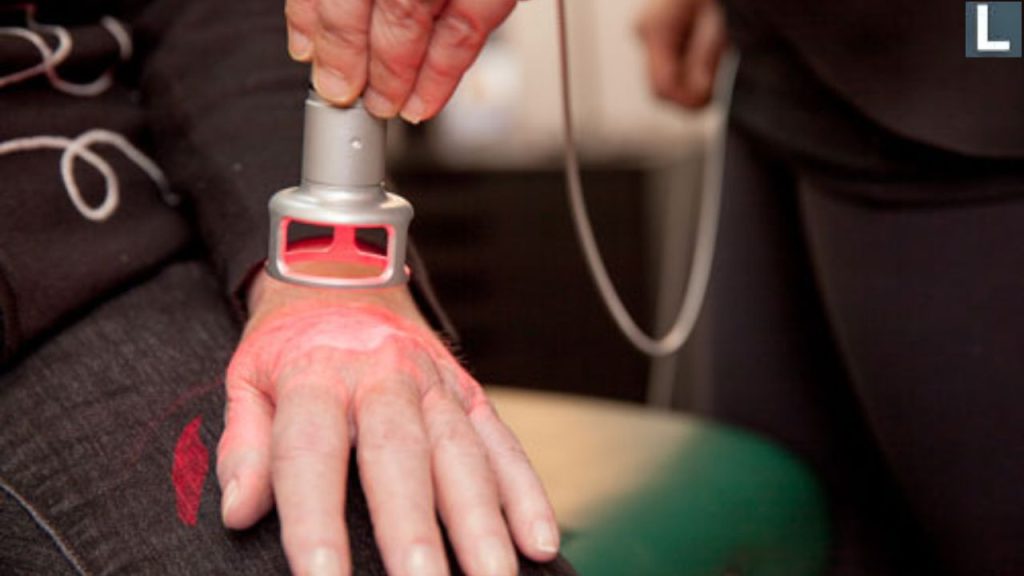Laser therapy continues to gain attention for its effective role in promoting recovery, improving functional performance, and helping the body adapt to change.
This article explores how class 4 laser therapy supports the body’s natural processes by influencing cellular behavior and stimulating neurological activity. It also outlines the difference that high intensity laser therapy can make compared to traditional methods, increasing the effectiveness of laser therapy.
This form of laser technology is used by professionals as part of a broader strategy to support neuroadaptive responses and enhance how the brain and body communicate.

What Is Class 4 Laser Therapy?
Class 4 laser therapy uses high-intensity laser light that penetrates deep into tissue. The laser energy interacts with cells to influence metabolism, circulation, and cellular repair. The beam is strong enough to stimulate physiological changes that may support neurological processing and tissue regeneration.
Unlike older forms of laser technology, the higher effectiveness of laser therapy in class 4 devices is because the devices deliver power levels that allow for shorter treatment sessions and faster outcomes.
How Class 4 Laser Therapy Works
High intensity laser therapy (HILT) targets specific regions of the body with focused energy. When applied over key points, the laser activates a series of responses.
At the same time, low-level laser therapy (LLLT) is not very effective and low level laser therapy side effects may include skin irritation, redness, or even headaches.
Benefits of class 4 laser:
- It stimulates blood flow
- It supports oxygen transport at the cellular level
- It influences enzyme activity inside cells
- It may promote tissue remodeling and recovery
By supporting these biological functions, the laser can help optimize the body’s adaptive responses and enhance the way it integrates sensory input.
Note: If you’re wondering “is laser therapy effective for knee pain?”, then yes, it can be, when other care instructions are also followed.
Supporting Motor Function and Brain Performance
Research has shown that class 4 laser applications, especially near the head and spine, can activate regions of the brain responsible for improved motor coordination and postural control.
Some findings suggest laser therapy is not limited to surface tissue, it also holds potential to support higher brain functions when used with care and purpose by professionals.
Enhancing Sensory Integration and Neural Processing
Each time light energy is introduced through laser therapy, the brain receives new sensory signals. These signals appear to stimulate neuroplastic activity, the brain’s ability to adapt and rewire itself in response to new input.
Through repeated sessions, class 4 laser therapy may help improve how the body:
- Perceives and responds to stimuli
- Coordinates movement and balance
- Integrates sensory information from the environment
This opens the door to using the effectiveness of laser therapy as a tool for supporting complex neurological functions—especially when paired with other forms of guided sensory training.
Applications of Class 4 Laser in Neuroadaptive Support
High intensity laser therapy can be used in a variety of care settings to support:
- Motor planning and postural alignment
- Coordination and balance challenges
- Recovery after physical setbacks
- Cognitive integration in motor-based tasks
To achieve the best results, laser therapy is typically used alongside focused movement-based strategies, sensory feedback tools, brain-based exercises, and chiropractic care. Together, they help recalibrate the body’s internal map and improve efficiency in day-to-day tasks.
What to Expect During a Session
During a laser session, a certified professional will guide a handheld laser device over targeted areas. The session may last between 5 and 15 minutes depending on the focus area.
- You may feel warmth at the application site
- You will likely feel more relaxed or alert afterward
Note: There is no downtime needed. Some people experience changes after a single session, while others benefit from a consistent schedule over several weeks.
Is It Safe?
Class 4 laser therapy is considered safe when performed by trained professionals. Protective eyewear is used during treatment. The therapy provider also adjusts energy settings tailored to match body type and goal of the session.
Unlike older laser types, class 4 devices are faster, more targeted, and do not involve discomfort when used correctly.
Laser Therapy and Neuroplasticity
Spinal adjustments and class 4 laser therapy both affect sensory input. When used in combination, they may amplify the effect of each modality.
Here’s how:
- Adjustments send powerful input into the nervous system
- Laser adds an additional layer of stimulation
- Both influence brain regions responsible for movement and perception
- Over time, these inputs can reshape neural maps and improve performance
Note: These approaches are not simply about relieving tension or easing symptoms. They’re about teaching the brain how to build better movement patterns and better adapt to its surroundings.
Summary
Class 4 laser therapy is used to:
- Activate tissue repair
- Improve circulation
- Stimulate the brain’s sensory pathways
- Support adaptive motor learning
- Increase the effectiveness of neurofunctional strategies
Laser therapy involving class 4 lasers offers a modern way to support change at both the structural and neurological level.
Who May Benefit
Individuals who may benefit include those seeking to:
- Improve balance and coordination
- Enhance movement efficiency
- Rebuild sensory-motor skills after prolonged inactivity
- Increase engagement with multi-sensory environments
- Build better brain-body communication
Note: When done by a trained professional, laser therapy is always guided by thorough assessment and is adjusted to meet individual needs.
Conclusion
The effectiveness of laser therapy lies in its ability to influence biological and neurological systems at once. Class 4 laser devices, when paired with movement-based care strategies, can help improve brain-body integration and support the body’s higher levels of natural function.
Every pulse of laser light is a message that helps the body adapt, learn, and thrive in response to its environment.


